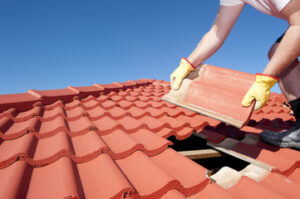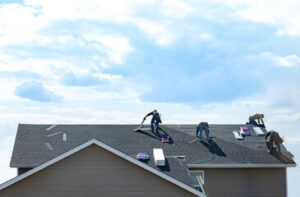A healthy roof is an essential component of any home. However, Montana Roofing Solutions installation is a large-scale project that can be intimidating to homeowners.

Fortunately, you can ease your nerves by knowing what to expect from the process. The first step is obtaining all the necessary permits for your project.
Roll roofing is a quick and cheap option for covering roofs. The material comes in a variety of colors and can be applied over an existing degraded roof to save on costs, but it can be more difficult to maintain than other roofing materials. Roll roofing also offers limited insulation properties, making it a poor choice for homes in climates with high rainfall or severe wind conditions.
Roll roofs are usually installed in two layers: a base sheet and a cap sheet. The sheets should overlap on their sides and ends by a minimum of 3 inches, so water cannot seep in between them. The overlapping edges and vents should be sealed with roofing cement to protect against leaks. It’s recommended to apply a reflective roof coating over the top of the roll roofing to reduce heat absorption and extend its lifespan.
In addition to the above, homeowners can help their roll roofing last longer by ensuring that downspouts are properly draining and that any interior roof drains are free from debris or buildup of snow or ice. Regular inspections are the best way to spot potential problems before they become costly or dangerous. Especially in the fall and spring, when harsh winter weather often occurs, these routine checks can help keep your roof in tip-top shape and prevent costly repairs or replacements in the future.
Unlike shingles, which must be installed one at a time, roll roofing can be laid out and then nailed down with a staple gun. This is a more efficient method of installation, which means it’s easier to cover larger roof surfaces with roll roofing than it would be with shingle installation.
The main drawback of this type of roof is that it doesn’t offer as much durability as other roofing options and can be less appealing for a home’s appearance or resale value. Additionally, it’s not a good fit for steep-sloped roofs and may not provide adequate drainage on these types of roofs.
If you’re considering a roll roofing system for your roof, it’s important to consult with an experienced roofing contractor to make sure the roof is prepared properly. This includes removing any gravel or debris that could puncture the roofing and ensuring that downspouts are draining properly. It’s also a good idea to inspect the roof periodically, particularly after significant weather events or in the case of an older home, before any major maintenance work is done.
Three-Tab Asphalt Shingles
In the roofing industry, there are several different types of asphalt shingles to choose from. Three-tab shingles are the most popular type of residential shingle and can be found on most homes. They offer a simple, traditional style that is affordable and durable. 3-tab shingles are available in a variety of colors and can complement many home aesthetics.
In terms of durability, 3-tab shingles are one of the most cost-friendly options and can last up to 20 years. This makes them a great choice for homeowners on a budget who still want to protect their home from the elements.
Three-tab shingles get their name from the fact that each individual shingle has three tabs cut into the bottom edge. These tabs fit together like puzzle pieces when they are installed, and they create a uniform look for the roof. The overall composition of these shingles includes an asphalt and adhesive base layer with outer granules backed by fiberglass. In comparison, architectural shingles, also known as dimensional shingles, are more substantial and appear thicker than 3-tab shingles. This is due to the fact that they have a stronger binder, and their outer granules are of a finer quality.
When choosing a shingle type for your home, it’s important to consider the longevity and the look that you would like. The durability of a shingle can have a significant impact on the way that it looks and performs, especially when it’s exposed to the elements every day.
The lifespan of a roofing material depends on how well it’s made, the materials used to make it, and the environmental conditions where it’s used. As long as the shingles are properly installed and maintained, they will last for several decades.
There are 3 primary roofing shingle types available: 3-tab, architectural, and premium. Each of these shingle types has its own set of pros and cons. To help you decide which shingle is right for your home, we’ve provided an overview of each type: basic information, look, costs, lifespan, and warranty.
Metal
Metal roofing is often associated with industrial and commercial buildings, but it can also be found on residential structures. It comes in a variety of shapes, sizes and colors, and can be used to create unique architectural designs. When installed properly, metal can add both strength and beauty to a building’s exterior. A good installation process involves a number of steps, including proper preparation and adherence to local code requirements.
To begin your project, make sure the roof is free of debris and that you have a clear area for working. Metal panels and trim have sharp edges, so only trained installers should handle them. Once the work begins, you’ll need to protect yourself and your surroundings with gloves and goggles. It’s important to use a safety harness when working on a metal roof because it can be dangerous if you fall.
Obtain the necessary permits for your project before you start, and be sure to follow any regulations set by your jurisdiction. It’s also a good idea to have a qualified inspector on hand during the process to ensure that everything is in line with local code and safety standards.
Begin by measuring the roof to determine how much material you’ll need. You should always purchase 10% to 15% more material than you think you’ll need. This extra material will allow you to account for any mistakes you might make or the fact that you might have to cut a piece of metal to size.
Once you’re ready to install the panels, begin at the eaves and work your way up. Ensure that the edges of each panel overlap at least one inch with the next one, and apply silicone sealant to both the long edge and the short edge of the first panel you lay down.
After the overlapping panels are in place, install the flashing. Flashing is a strip of metal that seals the different sections of the roof. It usually covers joints that are less than 140 degrees, such as the eaves or valleys of the roof. To install these pieces, you’ll need to have a tool that will bend sheet metal to fit the needed shape.
Architectural Asphalt Shingles
There are numerous roofing materials to choose from when you’re looking to re-roof your home or construct a new roof for your construction project. The type of material you select will have a major impact on its durability, aesthetics, longevity, and cost. Traditional asphalt shingles are one of the most common roofing options available to homeowners. They’re affordable, durable, and easy to install and repair.
Architectural or dimensional asphalt shingles are a bit more expensive than 3-tab shingles but offer better longevity and better aesthetics. They can be constructed to resemble many different types of roofing, including cedar shakes and slate shingles. They’re also known as composition shingles because they are made from a combination of materials that include fiberglass, organic felt, and mineral granules. The asphalt serves as a waterproofing agent, while the other materials provide strength, durability, and resistance to harsh weather conditions.
The primary difference between traditional 3-tab shingles and architectural shingles is in their thickness. The base mat on an architectural shingle is thicker than that of a 3-tab shingle, and it comprises stronger adhesives and more granules. This results in a sturdier shingle with improved wind resistance and longer warranties.
In addition to their increased durability and longevity, architectural shingles are also available in a much wider array of colors than 3-tab shingles. This allows you to create a distinctive look for your roof that can add to your home’s curb appeal. They can also be crafted to resemble other types of roofing materials, such as wood or slate, which might make them a more attractive option for older homes with existing roofs that still need protection.
It’s important to understand the differences between these two different types of shingles when choosing the right roofing material for your home. The choice you make will depend on a number of factors, including your budget, how long you want the roof to last, and whether or not you plan to live in the house for long enough to recoup the initial investment. The best roofing contractors in Fairhope can help you determine which type of shingle is best for your home.

